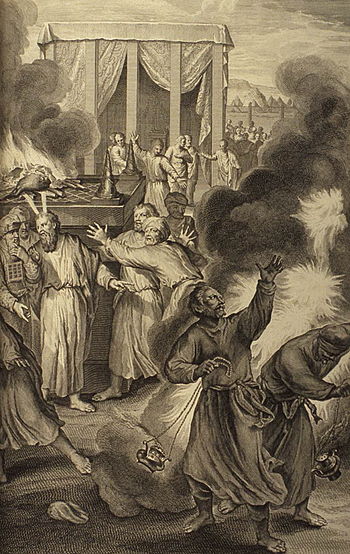What happened on the Day of Atonement?
 |
| English: Nadab and Abihu consumed by fire from the Lord; illustration from "Figures de la Bible", illustrated by Gerard Hoet (1648-1733), and others, and published by P. de Hondt in The Hague in 1728; image courtesy Bizzell Bible Collection, University of Oklahoma Libraries. (Photo credit: Wikipedia) |
The high priest would cast lots to determine which would go to God and which would go to “Azazel.” He would then sacrifice the goat assigned as God’s goat as a sin offering. Azazel’s goat is sent off into the wilderness to make purification. The exact meaning of the term “Azazel” is unknown; it may refer to a wilderness demon, a rocky cliff, or a goat bringing destruction. Essentially, Azazel’s goat was a scapegoat which departed into the desert and removed or carried away the sins of the people.
Leviticus 16:11–18 tells how the high priest is to sacrifice the bull to atone for his sins, then how to sacrifice the goat for the people’s sin offering. First, he purifies the most holy place and the tent of meeting through sprinkling blood on the “mercy seat.” He then takes blood from the bull and from the goat and cleanses the great altar. Next, he lays hands on the goat’s head and confesses Israel’s sins. Then he sends the goat into the wilderness (Lev 16:22).
Changing into more elaborate clothes, the high priest is to leave the linen garments in the tent of meeting, bathe himself, and put on his clothes (Lev 16:23–24). He then sacrifices his own burnt offering and that of the people, making atonement for himself and for the people. The man taking Azazel into the wilderness bathes himself and washes his clothes (Lev 16:26). Then he may leave the wilderness and reenter the camp. The remains of the bull and goat used for a sin offering are taken outside the camp and burned (Lev 16:27).
Butler, T. C. (2012, 2013, 2014). Day of Atonement. In J. D. Barry, L. Wentz, D. Mangum, C. Sinclair-Wolcott, R. Klippenstein, D. Bomar, … D. R. Brown (Eds.), The Lexham Bible Dictionary. Bellingham, WA: Lexham Press.

